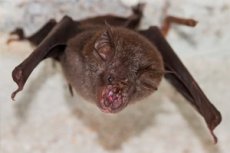New publications
Bats have been found to be vectors of new herpes viruses
Last reviewed: 02.07.2025

All iLive content is medically reviewed or fact checked to ensure as much factual accuracy as possible.
We have strict sourcing guidelines and only link to reputable media sites, academic research institutions and, whenever possible, medically peer reviewed studies. Note that the numbers in parentheses ([1], [2], etc.) are clickable links to these studies.
If you feel that any of our content is inaccurate, out-of-date, or otherwise questionable, please select it and press Ctrl + Enter.

In a recent study published in the journal Scientific Reports, a team of researchers from Wuhan, China, found that various species of insectivorous bats in central China are natural hosts or reservoirs of β- and γ-herpesviruses, with viruses in the Herpesviridae family showing host range restrictions and phylogenetic analysis indicating previous cross-transmissions between species.
Zoonotic diseases have always posed a serious threat to human health and the economy, given that the human immune system and global medical technology are often unprepared to combat these viruses that have crossed over from other animal species. The coronavirus disease 2019 (COVID-19) pandemic is a prime example of how zoonotic diseases affect human lives and the global economy.
Factors such as living in large groups and widespread distribution often result in bats acting as reservoirs for various pathogens. Genetic similarities between bats and other mammals such as humans and livestock have led to outbreaks of various zoonotic viruses such as severe acute respiratory syndrome coronavirus (SARS-CoV), Ebola viruses, lyssaviruses, and henipaviruses.
Viruses of the Herpesviridae family have linear, double-stranded deoxyribonucleic acid (DNA) with genome sizes ranging from 124 to 295 kilobase pairs (kbp). These viruses have been found in many animals, including mollusks, fish, amphibians, reptiles, birds, and mammals. Mammalian herpesviruses are divided into three subfamilies: α-, β-, and γ-herpesviruses, and many species of human herpesviruses, such as cytomegalovirus, Epstein-Barr virus, Kaposi's sarcoma-associated virus, and human herpesviruses 6A, 6B, and 7, are known to cause infections with severe morbidity.
In this study, the researchers collected different species of insectivorous bats from caves in different areas around Wuhan City in Hubei Province and used molecular techniques to determine the presence of herpesviruses in these bats. The epidemiological characteristics of the herpesviruses detected were studied using phylogenetic methods.
Bats were initially identified based on morphology, and then the cytochrome b gene was amplified using polymerase chain reaction (PCR) and sequenced from DNA extracted from these bats to confirm species identification. Genomic DNA obtained from liver and intestinal tissue was also used to perform nested PCR amplification targeting the dpol DNA polymerase gene in herpesviruses. In addition, the glycoprotein B gene was used to further characterize herpesviruses.
The Basic Local Alignment Search Tool, or BLAST, provided by the National Center for Biotechnology Information was used to obtain published herpesvirus sequences that were most similar to those sequenced in this study. The published sequences and those obtained in the study were then used to construct phylogenetic trees to understand the relationships between the newly discovered and previously identified herpesviruses. Cytochrome b sequences generated for bat species were also used to construct a host phylogenetic tree to determine patterns of correlation between herpesviruses and their hosts.
The study found four strains of the genus Betaherpesvirus and 18 strains of Gammaherpesvirus in 22 of the 140 bats collected. In the bat species Rhinolophus pusillus, or lesser horseshoe bat, the herpesvirus prevalence was 26.3%, while in the microbat species Myotis davidii it was 8.4%. The most frequently detected γ-herpesvirus strain was RP701, which also had the highest similarity to the ruminant γ-herpesvirus. One of the other Gammaherpesvirus strains, MD704, showed the highest similarity to the hedgehog γ-herpesvirus.
The distribution range of M. davidii extends from central to northern regions of China, while R. pusillus is found in the Indomalayan region. Other studies have also identified the herpesvirus strain RP701 in bats found in southern China, indicating that RP701 is widely distributed and shares a common ancestor with the herpesvirus found in ruminants.
Additionally, four β-herpesviruses were identified in M. davidii and showed 79% to 83% similarity to known β-herpesviruses. These β-herpesviruses also belonged to the same clade as β-herpesviruses identified in other bats of the family Vespertilionidae, to which M. davidii belongs. These results suggest that the new β-herpesviruses may have hosts other than M. davidii and that close contact between individuals of different Vespertilionidae species in colonies may facilitate interspecies transmission of these β-herpesviruses.
In summary, the study identified four new β-herpesvirus strains and 18 new γ-herpesvirus strains in 22 bats collected from areas around Wuhan. Two of the common strains have similarities to herpesviruses found in ruminants and hedgehogs, indicating potential for transmission to other mammals and possible zoonotic disease outbreaks.
These results highlight the need for ongoing surveillance of large bat populations and monitoring of viral reservoirs in these hosts to ensure preparedness for potential zoonotic disease outbreaks.
